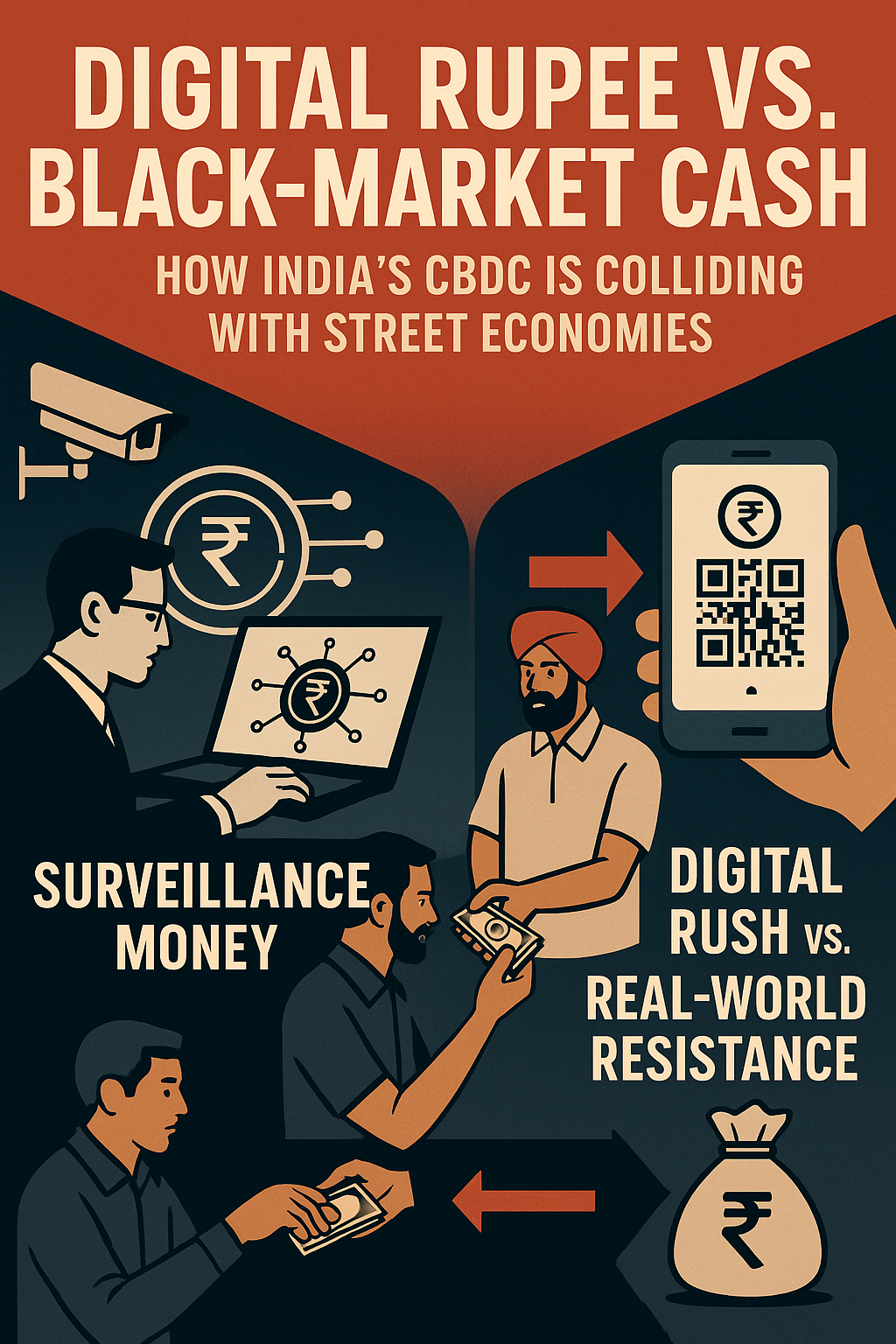Digital Rupee vs. Black Market Cash: How India’s CBDC Is Colliding with Street Economies
India’s digital rupee aims to modernize transactions and curb illicit finance, but its rollout is clashing with entrenched cash economies. Small traders and black market networks resist adoption, fearing surveillance, taxation, and disruption of long-standing informal financial practices.

Introduction: India CBDC Confronts the Black Market
While India charges forward with its Central Bank Digital Currency (CBDC) the e-Rupee there exists an old-world street economy that takes a stand in the guise of black-market cash. This is not merely an economic collision it's a fight over finance surveillance, cash versus digital money, and the deep-seated informality of hawala networks. In every QR code, there exists a shadowy realm of off-balance-sheet transactions that pose a challenge to the state's aspiration as well as Indian citizens' right to privacy.
1. The Digital Rupee: Sovereign Innovation or Surveillance Money?
What is the Digital Rupee?
Launched as pilot programs in late 2022, the Reserve Bank of India's Digital Rupee (e₹) operates on two arms wholesale (e₹-W) and retail (e₹-R). Based on blockchain and digital ledger technologies, it assures offline payments, programmable transfers, and full traceability.
The vision of the government: less cash dependence, lower logistics costs, and higher tax compliance. But beneath it is a more complicated reality—one that stretches the digital innovation-finance surveillance boundary.
Financial Surveillance: The Trade-Off
CBDCs enable the state to track every rupee spent. With programmability, the concerns are now increasing:
- Will all peer-to-peer transactions be traceable?
- Can the government assign expiry dates or expenditure ceilings on money?
- Is privacy even conceivable in a completely digital money system?
This is the conflict between digitization and civil liberties money that talks back to the state vs. the silent anonymity of cash.
2. The Enduring Value of Cash: Black Market's Final Redoubt
Why Cash Remains Supreme
In spite of aggressive digital thrusts after demonetization, cash remains supreme in:
- Hawala systems
- Black-market currency markets
- Informal retail, agricultural, and labor markets
Hawala, an ancient informal remittance network, works because it is:
- Anonymous
- Quick
- Affordable
In Indian metropolitans, small rooms leased by several agents operate hawala operations. Token passwords and corresponding currency note serials remain prevalent mechanisms that are used.
Recent Hawala Busts
- Multi-crore hawala operator seizures in Mumbai, Surat, and Delhi
- Cryptocurrency wallets with illicit cash transfers
- Fictitious export-import documentation for black money channeling
These indicate that money continues to grease the underworld of Indian finance.
3. Money Laundering: Hawala, Shells & Crypto – A Triad of Dark Finance
The Hawala Anatomy
Hawala works through trust-based intermediaries that settle accounts without moving money physically. An Indian sender hands over cash to a local intermediary, who asks his foreign counterpart to pay an equivalent amount to a recipient.
Key features:
- No paperwork
- Codeword-based access
- Deferred settlement with trade, crypto, or goods
Hawala Meets Crypto
Cryptocurrency introduces an additional layer. Balances are now settled with unregulated crypto wallets, usually blended with genuine blockchain transactions.
Recent raids expose the sophistication of this hybrid hawala-crypto scheme:
- Millions in seized wallets in Bitcoin, Ethereum
- Disguised marriage and business events to launder funds
- Crypto exchanges as shadow banking facilities for hawaladars
4. Street Economies vs. Digital Push: Real-World Resistance
Rural, Migrant & Marginal Realities
Cash isn't criminal to many Indians it's survival. Migrant workers, small farmers, and street vendors rely on:
- Informal credit networks
- Community transactions based on trust
- Visible, touchable cash
Digital cash needs smartphones, connectivity, and identification checks—all obstacles for millions.
Legal Grey Zones & Systemic Distrust
Political corruption controversy to administrative complicity in illicit trades, Indians have witnessed digital footprints abused or turned a blind eye to when influential interests are at stake. This begets deep suspicion of state-driven financial reform.
5. India CBDC's Challenge: Breaking the Shadow Chains
Digital Rupee's Promise
CBDC proponents claim that e₹ can:
- Enhance tax compliance
- Eliminate black money circulation
- Shake hawala and shell operations
It can also reduce the Rs. 50 billion spent on currency printing and distribution each year.
Limitations & Real-World Constraints
Lacking inclusive infrastructure, the e₹ would be a tool of surveillance rather than a force for democratization.
6. Policy & Legal Levers: Facing the Cash Underground
Regulatory Strengthening
India has equipped agencies with more potent instruments under PMLA and FEMA to penalize hawala and money laundering with jail terms and freezing of assets. But legal instruments require technological support and political intent.
Tech & Enforcement Battles
- Blockchain tracking software is now the norm for ED and IT raids
- More international collaboration on cross-border money laundering
- Financial intelligence units track suspicious patterns of behavior
But the street economy's ability to bounce back usually exceeds enforcement capability.
7. The Tipping Point: Where It All Comes Together
Surveillance vs. Privacy
In an era of programmable money, the fear is not only of tracking but control:
- Is money capable of being frozen or diverted?
- Will it be leveraged to punish dissent or unwanted conduct?
Public trust relies on openness, not force.
Financial Inclusion or Coercion?
When CBDC substitutes cash in the absence of proper infrastructure or trust, it can drive individuals out of the economy, not into it.
Shadow Markets' Resilience
Black economies adapt quickly. From phone-payment tokens to WhatsApp-based hawala codes, innovation is not the monopoly of the formal economy.
Conclusion: The Digital Money Revolution Isn't a Cold War—It's a Hot Battle
India's CBDC launch is a socio-economic reckoning. It paces innovation against resistance, transparency against anonymity, and state ambition against street pragmatism.
The questions ahead:
- Will CBDC gain trust outside urban elite circles?
- Can law enforcement break adaptive black-market strategies?
- Will privacy be preserved or abandoned in the name of progress?
The responses will determine whether India's economic future is inclusive, secure, and equitable or merely another battleground in the conflict between the monitored and the hidden.
Sources
RBI Digital Rupee official announcements and press releases
- CourtListener legal documents on PMLA/FEMA and Supreme Court comments on cryptocurrency
- Justia case files on black money and hawala
- Archive.org records on Jain Hawala scandal and past cash-based corruption cases
- Google Trends data on CBDC India and Hawala
- News reports from India Today, Times of India, The Telegraph, Financial Express, and The Blockchain
- VisionIAS and IJRPR policy analysis reports
- ED, IT Department, and Supreme Court public statements and enforcement data
For more legal exposes and truth-behind-glamour stories, subscribe to AllegedlyNewsNetwork.com




